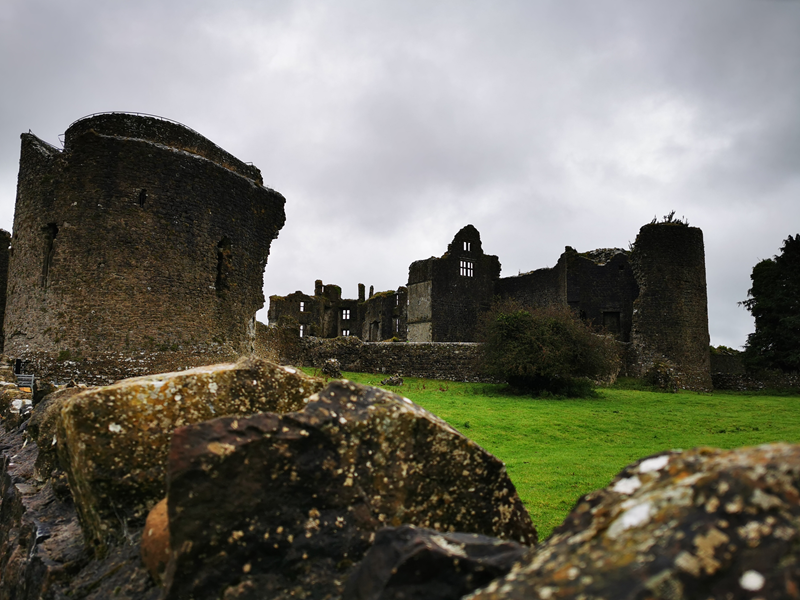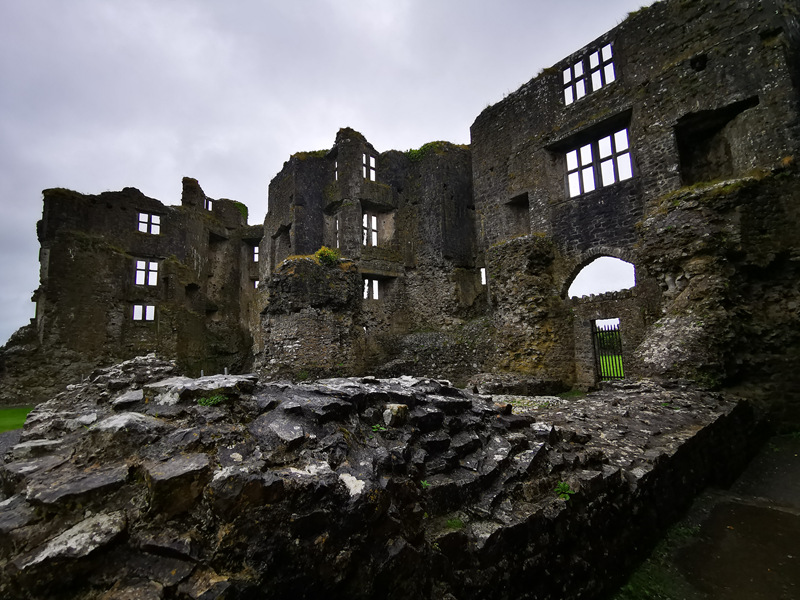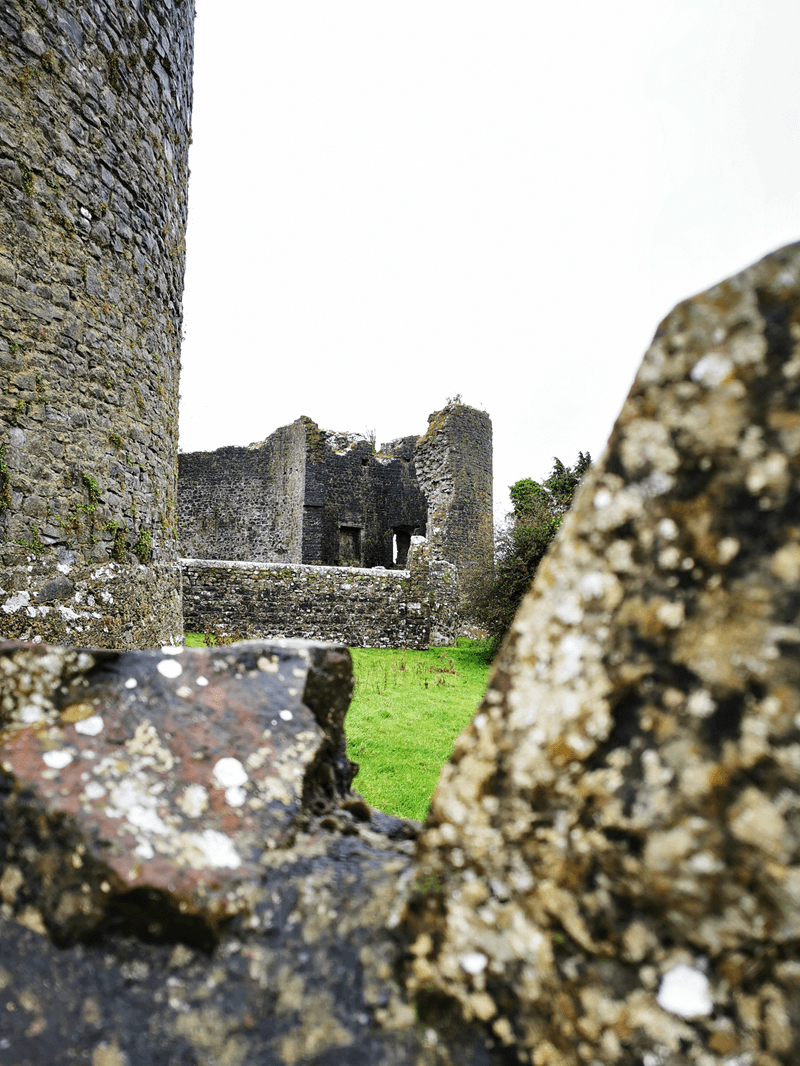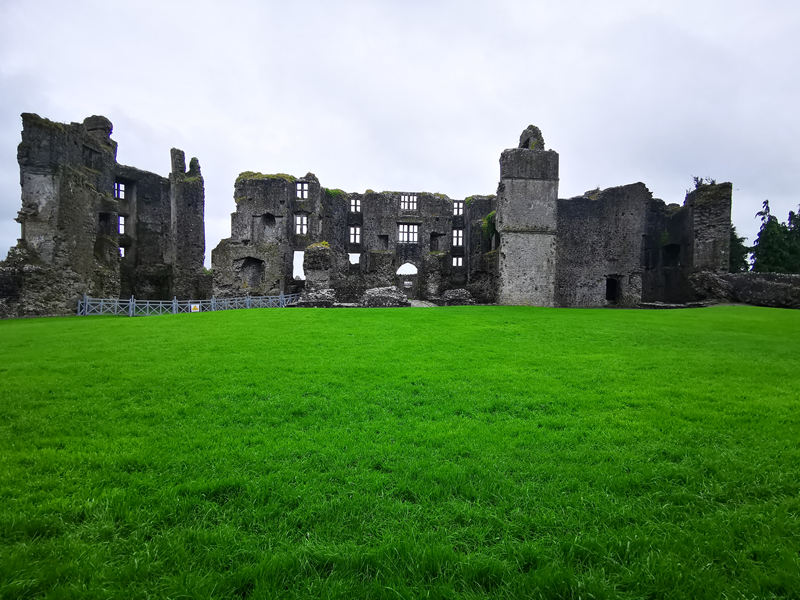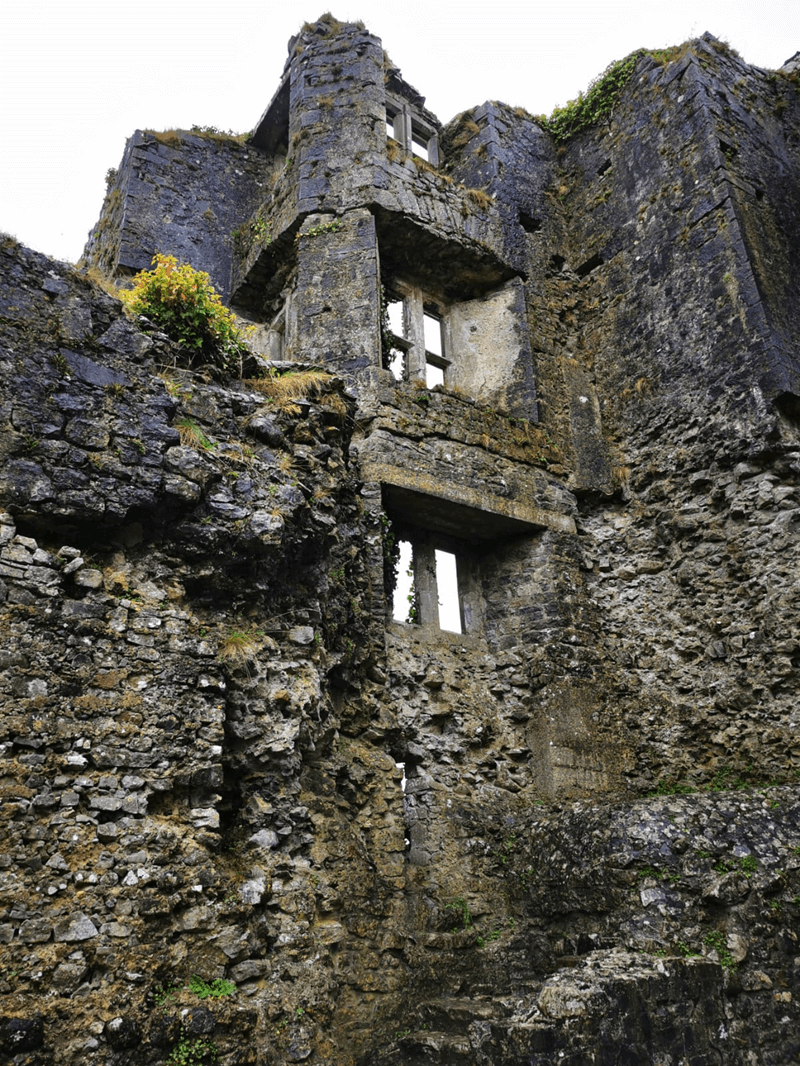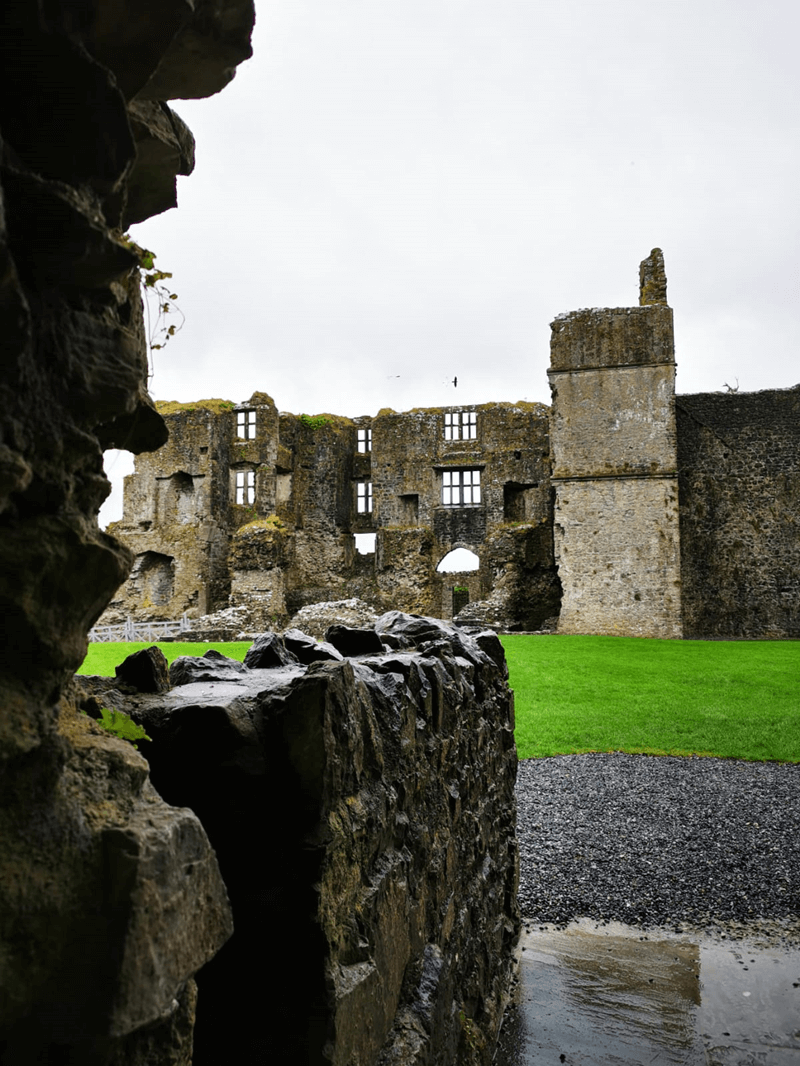History
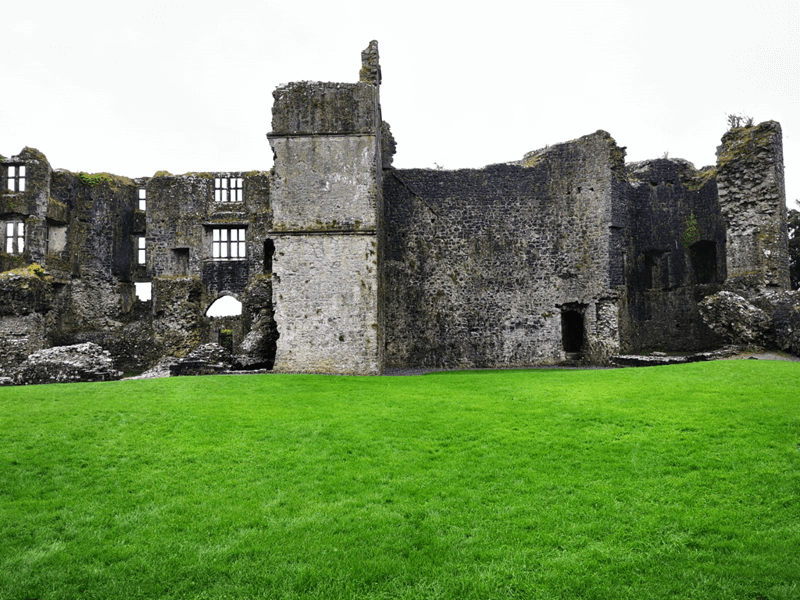
A very well detailed panel at the site entrance, commissioned by Roscommon Tidy Towns and prepared by Dr Kieran O'Conor (National University of Ireland, Galway), introduced us into the history of this castle and gave us several hints on its main architectural features. There is also an extremely interesting video on the Roscommon County Council Youtube channel, where Dr O’Conor provides a fascinating guided tour of Roscommon Castle [1]. Although some of the information reported on this page derive from these sources, we strongly encourage the reader to watch the video, in order to visit with more awareness the site.
Considered one of the finest Anglo-Norman castles of the 13th century in Ireland, Roscommon castle is a keep less nearly rectangular structure, measuring about 53 metres by 38 metres [2], with four towers occupying the corners of the perimeter, a twin-towered gatehouse on the front side (eastern side) and another gatehouse on the opposite side.
The story of Roscommon castle starts in the 13th century. Although the Anglo Norman invasion of Ireland had already begun about a hundred years before, the English crown started building castles in the critical areas of Ireland, trying to gain effective rule against the local Gaelic chieftains [2]. In this context, in 1262, Dublin government selected the site for the construction of a castle in Roscommon, with the intention to stop the raids carried out by the local O’Conor Gaelic family, fighting against the Anglo Normans. However, it was only in 1269 that works began, under the instruction of Robert de Ufford, Chief Governor in Ireland for Henry III. Therefore, the Lord of Roscommon Castle was the King of England in his position of Lord of Ireland.
There are several reasons why this location was chosen. First, the presence here of the O’Conors, led by the Irish King of Connacth, Feilim O’Conor, then succeded by his son Aedh, who represented a threat for the Anglo Normans. Hence, it was important to install in this area a defensive fortress, which also represented a visual sign of the royal might in this frontier region. Moreover, at that time, Roscommon was already a lively and prosperous centre in Ireland, representing an important metal working centre, with an Augustinian monastery and a Dominican friary. This factor also influenced the choise of the location.
There is another important reason, that is not immediately easy to guess. The clue comes from the name of the town where the castle is located: Loughnaneane. The name in fact derives from a lake that once existed on the site, known as Lough Nea or Lough Nen (Lake of the Birds). The presence of the lake was an important factor, because of its implications for the defence of the fortress: the lake protected the western side of it and, from the lake, a ditch was derived, running around the other sides. There was perhaps an additional reason: a few hundred meters away from where the castle stands, there could have possibly been an earlier O’Conor residence (a crannóg) laying into the lake, and hence, building the castle here was a symbolic act, proving that the Anglo Normans intended to interrupt and replace the O’Conor power.
 Documents suggest that the construction was quite slow due to several attacks by Aedh, who burned it in 3 or 4 occasions in the early 1270s while the castle was being built. Only in the late 1270s, after Aedh’s death in 1274, significant progress were made on the erection of the fortress.
Documents suggest that the construction was quite slow due to several attacks by Aedh, who burned it in 3 or 4 occasions in the early 1270s while the castle was being built. Only in the late 1270s, after Aedh’s death in 1274, significant progress were made on the erection of the fortress.
Various advanced defensive features were introduced by the Anglo Normans at Roscommon castle, which hence was one of the most important royal castles in Ireland. Research works concluded that there was also an outer stone wall or a timber palisade around the inner structure that we can see today and sorrounded on its turn by the ditch, with entrance located in front of the twin towered gatehouse, in a defensive fashion that resembles that of some Welsh castles of the time.
Arrow loops were present on the towers at the four angles of the structure and on the battlements defending the wall walk. Portcullises and drawbridges protected the entrance to the gatehouses. Moreover, the gatehouse included the residential accomodations for the constable of the castle, that is, the man nominated by the Dublin Governent to defend the castle on behalf of the King of England, typically an Anglo Norman knight. The gatehouses and the towers were equipped with guardrobes and fireplaces, for the comfort of residents and guests.
In the 14th century, the Gaelic resurgence started threating the Anglo Norman occupation and large part of the country came back under the control of Irish lords. In this scenario, after several attacks, by the mid 14th century the castle fell in the hands of the O’Conors, who were back in control of Roscommon.
In more detail, from the late 14th century, the O’Conors started having internal problems and eventually split into two branches: the Ui Conchobhair Rua or Roe (red haired O’Connor) and the O’Conchobhair Dunn or Don (brown haired O’Conor), most likely from the hair colour of the two O’Conors fighting for the dinasty. It appears that the O’Conor Don branch of the family remained in possession of the castle for more than 200 years. During all this period, the O’Conors did not carry out any major works to strenghten the castle. As discussed in [1], this could be probably a consequence of the organization of the Irish society, in which the partible inheritance principle discouraged owners from putting money into these works. Also the Gaelic wars were carried out using landscapes rather than fortifications.
The 15th century was quite turbulent for Roscommon Castle, which was besieged several times, during the wars that occurred in this period.
Starting from the 16th century, the attention of the English government for Roscommon Castle increased, as it was considered crucial for restoring the English control on this part of Ireland. Hence the castle was first surrendered by the O’Conor to Sir Henry Sidney, Lord Deputy of Ireland, in 1569 and then, in 1577, bestowed to Sir Nicholas Malby, governor of Connacht, along with a vast land around the castle, consisting of 17000 acres.
Roscommon Castle was the main residence of Malby and hence the castle underwent major renovation works in this period, turning it into a fortified mansion, inspired to the Renaissance style, as it can be recognized by looking at the symmetry of the new elements, such as the rectangular windows. In particular, a single four storey L shaped residential structure was built, running on two sides of the curtain wall, starting from the twin towered gatehouse. The original ditch was mostly filled up, except for a portion of it, which remained as part of a fortified walled garden. A tree line avenue was also added, connecting the town to the southern side of the castle. Roscommon castle became one of the largest fortified houses with Reneissance influence in Ireland, along with Portumna.
Although having introduced many ornamental elements, Malby did not abandon the use of defensive features, such as gun loops or the others from the original 13th century structure, as the local Irish families still represented a threat. Indeed, twice, in 1569 and in 1599, Red Hugh O’Donnell besieged the castle during the Nine Years’ War.
Roscommon castle was also involved in the Confederate Wars of the 1640s and surrendered to a Cromwellian force in 1652. Most likely, it was left abandoned after the Williamite Wars in the last decade of the 17th century, once the Jacobite Irish soldier Patrick Sarsfield probably ordered its demolition, to prevent it from being used again by the enemy.
Today the castle is in the care of the Office of Public Works (OPW) and is freely open to the public [2].
References
- [1] Youtube channel of Roscommon County Council, A Guided Tour of Roscommon Castle with Dr Kieran O'Conor, NUI Galway
- [2] Tarquin Blake, "Exploring Ireland’s Castles", The Collins Press, 2017
Other useful links
- Tuatha, Roscommon Castle
- enjoy-irish-culture.com, Castles In Ireland-Roscommon Castle
- Wikipedia, Anglo-Norman invasion of Ireland
- Dictionary of Irish Biography, Ufford (Offord), Sir Robert of
- Wikipedia, Felim O'Connor (d. 1265)
- Wikipedia, Áed na nGall
- Wikipedia, Henry Sidney
- Wikipedia, Nicholas Malby
- Wikipedia, Hugh Roe O'Donnell
- Wikipedia, Nine Years' War (Ireland)
- Wikipedia, Irish Confederate Wars
- Wikipedia, Williamite War in Ireland
- Wikipedia, Patrick Sarsfield, 1st Earl of Lucan
